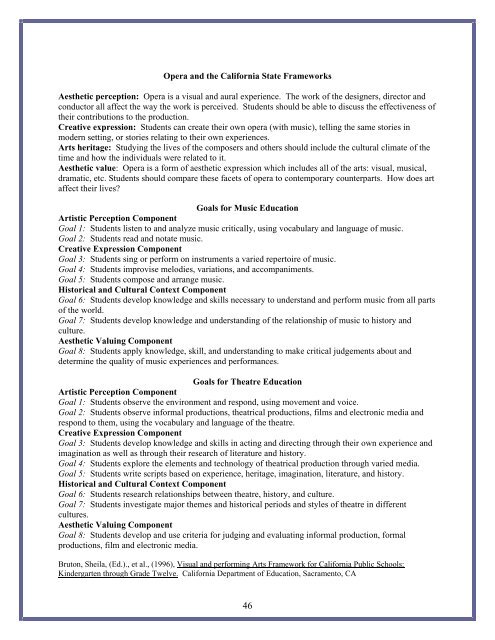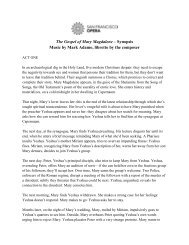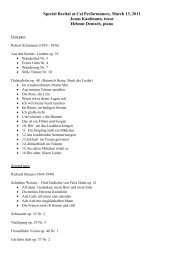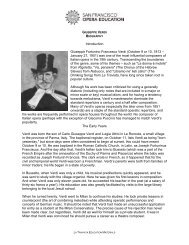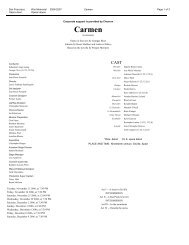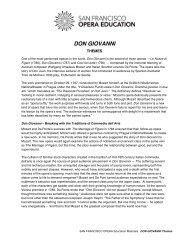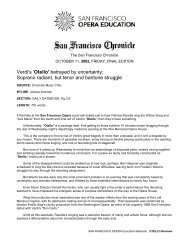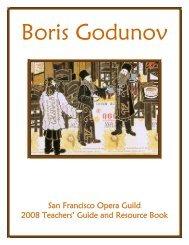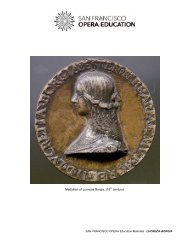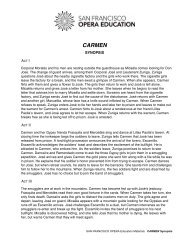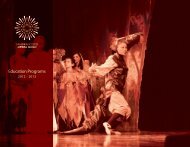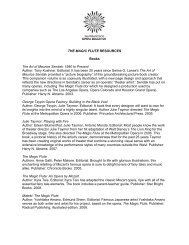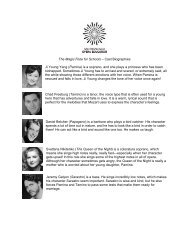You also want an ePaper? Increase the reach of your titles
YUMPU automatically turns print PDFs into web optimized ePapers that Google loves.
<strong>Opera</strong> and the California State Frameworks<br />
Aesthetic perception: <strong>Opera</strong> is a visual and aural experience. The work of the designers, director and<br />
conductor all affect the way the work is perceived. Students should be able to discuss the effectiveness of<br />
their contributions to the production.<br />
Creative expression: Students can create their own opera (with music), telling the same stories in<br />
modern setting, or stories relating to their own experiences.<br />
Arts heritage: Studying the lives of the composers and others should include the cultural climate of the<br />
time and how the individuals were related to it.<br />
Aesthetic value: <strong>Opera</strong> is a form of aesthetic expression which includes all of the arts: visual, musical,<br />
dramatic, etc. Students should compare these facets of opera to contemporary counterparts. How does art<br />
affect their lives?<br />
Goals for Music Education<br />
Artistic Perception Component<br />
Goal 1: Students listen to and analyze music critically, using vocabulary and language of music.<br />
Goal 2: Students read and notate music.<br />
Creative Expression Component<br />
Goal 3: Students sing or perform on instruments a varied repertoire of music.<br />
Goal 4: Students improvise melodies, variations, and accompaniments.<br />
Goal 5: Students compose and arrange music.<br />
Historical and Cultural Context Component<br />
Goal 6: Students develop knowledge and skills necessary to understand and perform music from all parts<br />
of the world.<br />
Goal 7: Students develop knowledge and understanding of the relationship of music to history and<br />
culture.<br />
Aesthetic Valuing Component<br />
Goal 8: Students apply knowledge, skill, and understanding to make critical judgements about and<br />
determine the quality of music experiences and performances.<br />
Goals for Theatre Education<br />
Artistic Perception Component<br />
Goal 1: Students observe the environment and respond, using movement and voice.<br />
Goal 2: Students observe informal productions, theatrical productions, films and electronic media and<br />
respond to them, using the vocabulary and language of the theatre.<br />
Creative Expression Component<br />
Goal 3: Students develop knowledge and skills in acting and directing through their own experience and<br />
imagination as well as through their research of literature and history.<br />
Goal 4: Students explore the elements and technology of theatrical production through varied media.<br />
Goal 5: Students write scripts based on experience, heritage, imagination, literature, and history.<br />
Historical and Cultural Context Component<br />
Goal 6: Students research relationships between theatre, history, and culture.<br />
Goal 7: Students investigate major themes and historical periods and styles of theatre in different<br />
cultures.<br />
Aesthetic Valuing Component<br />
Goal 8: Students develop and use criteria for judging and evaluating informal production, formal<br />
productions, film and electronic media.<br />
Bruton, Sheila, (Ed.)., et al., (1996), Visual and performing Arts Framework for California Public Schools:<br />
Kindergarten through Grade Twelve. California Department of Education, Sacramento, CA<br />
46


